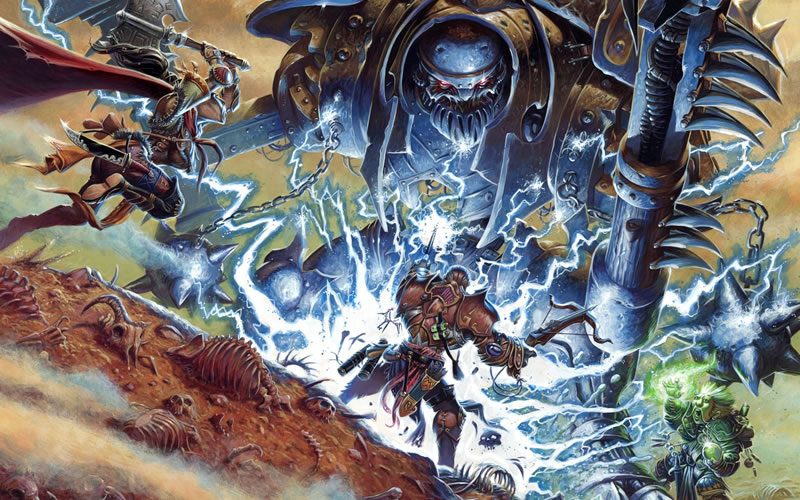Not Feeling the Inspiration? 3 Alternatives for D&D Fifth Edition

We’re getting near the end of October and Tribality’s Triversary celebration is almost complete. Before the month ends, I wanted to embrace Tribality’s third birthday by looking at three alternatives to using Dungeons & Dragons 5e’s advantage mechanic.
The Fifth Edition of Dungeons & Dragons was released way back in in 2014, just before Tribality launched. For past editions, three years would have been the half-way point of its lifecycle, but I think we’ll be seeing this edition for a while. When 5E was first released, some of the most talked about rules were advantage, disadvantage and inspiration, which all let you to roll an additional d20 and take the higher of the two (or lower for disadvantage).
For me, advantage and disadvantage has been an amazing addition to the rules, allowing me to quickly provide a bonus or penalty to a PCs or NPCs and avoid the many floating modifiers that were present in past editions. If the players come up with a good idea, I’ll usually reward them with advantage to bring that idea to life with the rules. I think it is one of the best things about playing 5e for me on both sides of the table and as a designer.
From the Dungeon Master’s Guide
“Inspiration is a rule the Dungeon Master can use to reward you for playing your character in a way that’s true to his or her personality traits, ideal, bond, and flaw.”
When I first read about inspiration, it sounded like a great idea, and I was always looking for ways to provide a bonus d20 for a player who brings their PCs traits, ideal, bond, and flaw into gameplay. The goal of inspiration is to provide a mechanical reward for good roleplay, and I am sure for many tables this rule has been an awesome addition for their table. Many times in my games, I have found it hard to remember to give out inspiration and handing it out at the end of the game with experience points (xp), is far removed from the event that earned the player inspiration. Even when I did hand out inspiration, the reward (unlike inspiration) had no impact on the situation it earned in, and was to be used far off in the future.
I’m sure if I created physical tokens, I might do a better job at remembering, but who has time (arms raised up like an infomercial actor). When I tried to have the players give it out to each other, they forgot too. It seems that when our group is in the middle play, the last thing we remember to do is hand out inspiration. That being said, we all really liked having inspiration to roll or give to another player when an important roll was coming up such as an important attack or death save in a boss battle.
I present the following three alternatives to inspiration that you might want to try at your table.

1) Action Points or Hero Points
Like Inspiration, Action Points give players a way to affect mechanical game play, by improving important rolls. Unlike Inspiration, a player does not earn Action Points from gameplay, but is given a limited number of Action Points, beginning at first level and each time they level up. Once an Action Point is spent, it is gone for good, but they are meant to be spent as they can’t be saved up and carried over during level up. In 3.5, Action Points have even be used to gain extra uses of certain class powers.
For my current campaign, I am running Tomb of Annihilation in Eberron’s Xen’drik, and I am using Action Points as an alternative to Inspiration. Here are my homebrew rules, which heavily borrow from the DMG’s Hero Points, UA: Eberron and the 3.5e Eberron Campaign Guide. The alternative rules below scale as PCs level up, like the original 3.5 rules. I’m hoping Action Points will help my players feel more like they’re in a pulp adventure versus a survival horror, and free us from forgetting about inspiration as we explore the jungles. I also read on reddit and forums, that Action Points can work really well for buffing up a smaller party. NPCs and monsters aren’t generally created with action points, I would stick with Legendary Resistance and Lair Actions features and not hand them out to villains.
ADDED: Another alternative version of action points would be just to turn the d6s into having advantage. I think this would be a wash on average (I think the stats show that advantage works out to around +3.5), which is close to the average for a d6 roll, but advantage does give a second chance to get a crit/natural 20.
The Eberron campaign setting introduced Action Points as a method for players to alter a d20 roll in dramatic situations, allowing for a potentially crushing failure to be turned into an amazing heroic success.
UA: Eberron/Hero Points Heavily Inspired Action Points (the one I am using)
- At first level, you have 5 action points.
- Each time you gain a level, you lose any unspent action points and gain a fresh supply of action points equal to 5 + ½ your level, rounded down.
- You can spend an action point whenever you roll a d20 to make an attack roll, an ability check, or a saving throw.
- You don’t have to decide until after you make the d20 roll and learn if it succeeded or failed.
- If you spend an action point, roll a d6 and add the result to your d20, possibly changing a failure into a success.
- You can spend only 1 action point per roll.
- In addition, whenever you fail a death saving throw, you can spend an action point to make it a success.
3.5 Inspired Action Point Variant (likely too powerful for 5e smaller modifiers)
- At first level, you have 5 action points.
- Each time you gain a level, you lose any unspent action points and gain a fresh supply of action points equal to 5 + ½ your level, rounded down.
- You can spend an action point whenever you roll a d20 to make an attack roll, an ability check, or a saving throw.
- You don’t have to decide until after you make the d20 roll and learn if it succeeded or failed.
- If you spend an action point, roll a d6 and add the result to your d20, possibly changing a failure into a success.
- From 1st to 7th level, you can spend only 1 action point per roll.
- Starting at 8th level, you can spend 2 action points per roll, and apply the higher d6 result to your d20.
- Starting at 15th level, you can spend 3 action points per roll, and apply the highest d6 result to your d20.
- In addition, whenever you fail a death saving throw, you can spend an action point to make it a success.

2) Just Start with Inspiration
I don’t think inspiration is a bad system, I just think that many DMs like me find it hard to remember to give it out during the game. I’ve read a number of people propose just having players start each game session with one inspiration token. This is how Action Points worked in D&D 4th edition, and players earned additional tokens when they successfully completed encounters that session. With this system, you’re sure to start using inspiration and by getting in the habit, you players might start to try to figure out way to earn more tokens.
Once players spend their token they can earn additional tokens by:
- having the DM or players finally remember to give out inspiration and provide a bonus d20 for a player who brings their PCs traits, ideal, bond, and flaw into gameplay.
- have a ‘play of the game’ after a social, exploration or combat encounter where the DM or players reward a player for good roleplay, smart thinking or pulling off an awesome move.
- just give out additional tokens at milestones when the group achieves a major success (like 4e Action Points)
Angry DM wrote about 11 Ways to Take the Suck Out of Inspiration in D&D, including having players starting a session with inspiration. I think that the drawback of using a system like this, is that inspiration just turns into another resource on the character sheet, like Action Surge, to be used sparingly versus being earned for excellent gameplay.

3) Prep Dice and Twist Points
I ran a D&D 5e heist one-shot for the GM Showcase podcast a year ago. DM Mitch of the Dungeon Master’s Block asked me to be a guest GM to run a one-shot for the podcast. I set the game in an alternative 19th century Earth, where steampunk tech and magic created a much different 19th century than the one from our world. We decided on using Dungeons & Dragons 5th edition to run the game with some unique mechanics to allow for some twists and turns in the story.
Here are the homebrew rules I created to replace inspiration. The goal of these rules was to develop something that I thought would work well for a team planning a heist and to reward preparation and allow for the twists the genre is known for. Twist Points might be an interesting mechanic you can introduce for a one-shot or even a full campaign full or heist and intrigue.
Prep Dice
- For challenges the players know about in advance and can prepare for – they have advantage on related skill checks when they come up in game
- Each known challenge that is prepared for gives the player 1 PREP DIE – an additional 1d8 they can apply to one task’s related skill check during the execution of the heist.
- Failed skill checks shouldn’t kill the job, but can add additional time and other potential complications
Twist Points
- The GM starts the game with a token which represents one twist point.
- So if the players had a perfect map of a bank and were going to come in through the basement of the building next door, the GM could use a twist point to tell the players that they find out their planning and preparation didn’t find that the wall cracked 10 years ago and was fixed and reinforced, making it tough to dig quietly in one night through to the bank next door.
- A player could use a twist point to remind the GM that the PCs leased the building next door and already knew that, handing the GM 2500gp in exchange for the 12 month lease and all the time they need.
- Once the GM uses a token to throw a twist at the players, the GM passes the token back to the players, who can use it to throw a complication at the GM, but that will give the token back to GM and so on, but both the GM and players can each only use a token once per scene
You can find the variant Plot Points rules in the DMG (page 269), which provide a similar story based mechanic that allow players to change the course of the campaign. Twist or Plot Points can be extremely overpowered. Instead of impacting a single important roll, they can reshape an adventure or even an entire campaign.
Let us know what you think of these three alternatives in the comments below.



